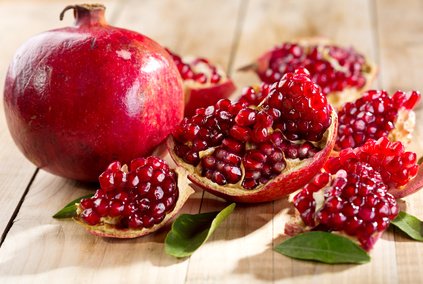Pomegranates: The Crown Jewel of Superfoods
Pomegranates are a part of many cultures around the world and are often symbolic of good fortune, abundance, and as in Persian wedding ceremonies, a joyous future. That seems fitting, since they contain so many powerful nutrients that improve health for a happier future.
Nutrients in Pomegranates
Each pomegranate has hundreds of delicious seeds filled with juice. In fact, in studies, pomegranate juice beat over ten different phytonutrient-rich beverages (like Concord grape, acai, and blueberry juice) by at least 20% for phytonutrient potency. The phytonutrients called polyphenols (like powerful anthocyanins) in pomegranates help keep cholesterol in the less damaging form to prevent plaque build up in the arteries, and to reduce plaque that has already built up. Along with boosting heart health, pomegranates also appear to prevent and kill off cancerous cells and to decrease inflammation, thought now to be an underlying cause of chronic disease.
For greater nutrition and that desirable crunch, eat the whole seed. The seeds in one pomegranate contains almost half of your daily recommended vitamin C, more than half of vitamin K, several B vitamins including folate, potassium in similar amount to a banana, and good amounts of phosphorous, copper, and manganese. Furthermore, one large pomegranate contains 11 grams of fiber, which is almost half the fiber we need per day.
While pomegranates are commonly eaten around the world, they seem daunting to those who weren't raised eating them. There are a few ways to unlock these delicious crunchy seeds bursting with flavorful juice. Some advise you to cut them in half and use a wooden spoon to whack the seeds out of the pomegranates. However, it's easy and less messy to cut into the fruit without bursting any seeds, so there is no spilled, messy juice.
Slice about 1/4 inch of the stem end and cut off the crown on the other end by cutting a circle around and under the crown until it comes out. Starting at the cut-out crown hole, cut through the red skin along the six subtle ridges down to the stem end/bottom. Gently crack open the sections of the pomegranate over a large bowl to expose the red seeds and white membranes. Some people add water to their bowl and continue to separate the seeds from the membranes under water as the seeds drop to that bottom and the membranes rise to the top for easy separation. I skip the water, but bend the sections over the bowl to loosen the seeds, so they come right out as I knock them out with my fingers and the seeds drop into the bowl. Take December's Healthy Challenge and eat pomegranates while they are still in season for the next month. They add a scrumptious, juicy crunch to your recipes while boosting your health, and they are a gorgeous addition to your holiday recipes. I love hummus topped with pomegranate seeds, in salads (Pear Pomegranate Green Salad), as well as served with vegetables like roasted Brussels sprouts. They make food more attractive, nutritious and tasty! Happy Holidays!

